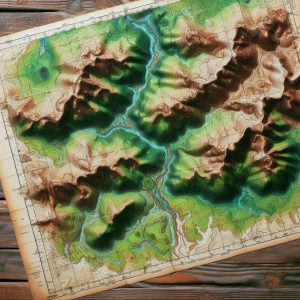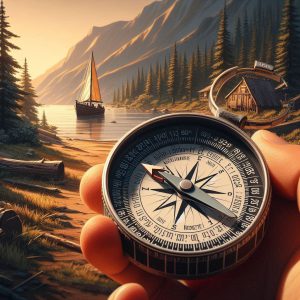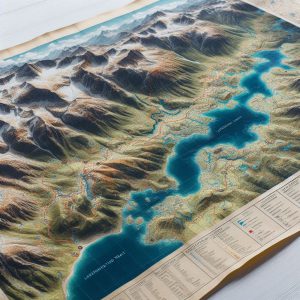Master Essential Wilderness Navigation Skills to Enhance Your Outdoor Adventures Without GPS
Gaining proficiency in wilderness navigation without the aid of modern technology may initially feel overwhelming. However, acquiring fundamental map and compass navigation skills is not just beneficial; it’s an invaluable asset that can significantly elevate your outdoor experiences. At its essence, effective navigation requires a comprehensive understanding of your surroundings and the capability to accurately determine your position in relation to your target destination. A map functions as a detailed two-dimensional portrayal of the landscape, while a compass offers a reliable means for orienting yourself according to cardinal directions: north, south, east, and west. By mastering these essential tools, you can confidently navigate the great outdoors without being tethered to technology.
Kickstart your navigation journey by thoroughly familiarizing yourself with the diverse symbols and scales found on a map; these elements are crucial for accurately interpreting the physical landscape and enhancing your navigational expertise. Understanding how to read contour lines, which indicate elevation changes, is vital as it enables you to identify hills, valleys, and other geographical features that could impact your route choice. Additionally, becoming adept at using a compass is equally important, as it empowers you to navigate successfully in the wilderness while remaining independent of GPS devices.
The compass needle consistently points toward magnetic north, allowing you to align your map with the actual terrain around you. To achieve this, hold the compass flat in your hand and rotate the map until the magnetic north on the compass aligns with the north indicated on the map. This essential process, known as “orienting the map,” is fundamental in maintaining accuracy during your navigation efforts, ensuring you stay on the correct path toward your destination.
Once your map is appropriately oriented, you can utilize the compass to take precise bearings that will guide your travel route. By effectively integrating these two powerful navigational tools—the map and the compass—you will be equipped to traverse unfamiliar landscapes with confidence, ensuring you remain on course even without modern technological aids.
Fundamental Principles for Successful Outdoor Navigation
- Achieving proficiency in map and compass navigation is essential for anyone engaging in wilderness exploration or various outdoor activities.
- Topographic maps provide intricate insights into the terrain, elevation, and natural features, all of which are crucial for successful navigation.
- A compass not only helps determine direction but also aids in effective navigation by aligning with the map’s orientation and understanding magnetic north.
- Natural landmarks and cues, including unique rock formations or distinctive tree patterns, can serve as effective navigational aids when a map or compass is unavailable.
- Estimating distance and travel time is vital for planning and executing a successful navigation strategy in the wilderness.
 Recognizing the Significance of Topographic Maps for Efficient Wilderness Navigation
Recognizing the Significance of Topographic Maps for Efficient Wilderness Navigation
Topographic maps are essential resources for anyone planning to venture into the wilderness, offering a wealth of information about the physical features of the terrain. These maps utilize contour lines to depict changes in elevation, allowing you to visualize the shape and steepness of the landscape, which is invaluable for preparing for the challenges that lie ahead. Each contour line connects points of equal elevation, and the spacing between these lines indicates whether the slope is steep or gradual. This knowledge equips you with the necessary tools for effective navigation and helps you anticipate the physical demands you may face on your journey.
Decoding Contour Lines and Map Symbols for Enhanced Navigation
When exploring a topographic map, it is crucial to pay close attention to the patterns created by contour lines; tightly spaced lines indicate steep terrain, while widely spaced lines suggest flatter areas. This understanding will empower you to anticipate potential obstacles along your route, enabling you to make informed navigation decisions. Furthermore, topographic maps are filled with symbols that denote various landmarks, including rivers, roads, trails, and types of vegetation. Familiarizing yourself with these symbols is fundamental for successful navigation, ensuring you can effectively utilize the map to guide your journey.
Developing Navigation Techniques Using Topographic Maps
For example, blue lines typically signify the presence of water bodies, such as streams or lakes, while green areas may indicate forests or dense vegetation. By cross-referencing these symbols with your surroundings, you can confirm your location and make necessary adjustments to your route. Additionally, topographic maps often feature grid lines that assist you in pinpointing coordinates, allowing for more precise navigation. By mastering the intricacies of topographic maps, you will deepen your appreciation for the landscape and enhance your overall navigational skills in the wild.
 Harnessing Compass Techniques for Accurate Directional Navigation
Harnessing Compass Techniques for Accurate Directional Navigation
An indispensable tool for any outdoor adventurer, a compass is vital for accurate directional navigation, especially when traversing unfamiliar landscapes. To use a compass effectively, begin by holding it level in front of you and allowing the needle to stabilize. The needle will point toward magnetic north, which may differ slightly from true north due to magnetic declination—the angle between magnetic north and true north varies based on your geographical location and should be taken into account for accurate navigation.
Before heading out on your journey, determining the local declination and adjusting your compass accordingly is crucial. This adjustment ensures that your bearings remain precise, aiding you in staying on course throughout your adventure. Once your compass is calibrated to account for declination, you can take a bearing that will effectively guide your travel direction.
To take a bearing, identify a landmark you wish to navigate toward and rotate the compass housing until the orienting arrow aligns with the magnetic needle. The degree reading on the compass dial that aligns with the index line indicates your bearing. As you move toward your destination, regularly check your bearing to confirm that you remain on track.
If you find yourself veering off course, reorient your compass and adjust your path as necessary. By mastering these techniques, you will gain the confidence to rely on a compass as a dependable navigational aid during any outdoor adventure.
 Utilizing Natural Landmarks and Cues for Effective Wilderness Navigation
Utilizing Natural Landmarks and Cues for Effective Wilderness Navigation
While maps and compasses are indispensable navigational tools, keenly observing natural landmarks and signs can significantly enhance your ability to navigate the wilderness effectively. Prominent features such as mountains, rivers, or distinctive trees can serve as invaluable reference points when traversing unfamiliar terrain. For instance, if you know a specific mountain is positioned to the east of your starting point, you can use it as a guide to ensure you’re heading in the correct direction.
Moreover, familiarizing yourself with the unique characteristics of your surroundings will aid in creating mental maps that enable you to navigate without solely relying on tools. In addition to prominent landmarks, be attentive to natural signs that may indicate directional changes or alterations in terrain. The sun’s position can serve as a helpful guide; in the northern hemisphere, the sun rises in the east and sets in the west, providing a general sense of direction throughout the day.
Additionally, observing moss growth on trees—often denser on the north side—can provide valuable clues about orientation in thick forests. Animal trails can also offer directional hints; many animals follow established paths that can lead you toward water sources or other significant landmarks. By refining your ability to interpret these natural signs, you will become increasingly adept at navigating a variety of environments.
Mastering the Art of Accurately Estimating Distance and Travel Time for Effective Navigation
Estimating distance and travel time is crucial for effective navigation in wilderness areas. Understanding how far you have traveled and how long it will take to reach your destination allows for better planning and helps avoid unexpected challenges. One practical technique for estimating distance involves pacing—counting your steps as you walk.
On average, an adult’s stride measures approximately 2.5 feet, meaning that by counting your steps over a known distance, you can estimate how far you’ve traveled based on your pace. Additionally, it’s essential to consider the type of terrain and elevation changes when calculating travel time. For instance, traveling over flat ground usually allows for quicker movement compared to navigating steep hills or rocky paths.
A common guideline suggests estimating that you can cover roughly three miles per hour on flat terrain, but this estimate should be adjusted significantly when faced with challenging landscapes. By taking these variables into account and modifying your expectations accordingly, you will be better equipped for your journey and more capable of managing your time effectively throughout your adventure.
Creating a Strategic Wilderness Route and Navigation Plan for Success
Designing Your Wilderness Route for Effective Navigation
Developing an effective navigation plan is essential before embarking on any wilderness adventure. Begin by studying topographic maps of the area you intend to explore, identifying potential routes based on prominent landmarks, existing trails, and accessible water sources. As you devise your route, consider factors such as changes in elevation and the difficulty level of the terrain; ensuring your plan is realistic and achievable is paramount for a successful adventure.
Preparing for Unexpected Obstacles and Weather Changes
While planning your route, it is wise to consider alternative paths in case you encounter unexpected obstacles or sudden changes in weather. Having multiple options will grant you greater flexibility during your journey and help ensure your safety. This adaptability is crucial for a successful and enjoyable wilderness experience, allowing you to navigate any challenges that may arise with ease and confidence.
Crafting a Comprehensive Navigation Strategy for Your Adventure
After mapping out potential routes, create a detailed navigation plan that includes critical waypoints. Mark these waypoints on your map and, if possible, note their coordinates, enabling you to track your progress as you navigate through the wilderness. Additionally, factor in estimated travel time between waypoints and identify any potential hazards you might encounter along your chosen route. This foresight will prepare you for a safe and efficient journey.
Ensuring a Safe and Rewarding Outdoor Experience
Thorough planning and anticipating challenges will enhance your chances of reaching your destination while enjoying a safe and fulfilling outdoor experience. A well-structured navigation strategy is vital for a successful wilderness adventure, ensuring that you can explore the great outdoors with confidence and assurance in your skills.
 Implementing Emergency Navigation Techniques for Unforeseen Scenarios
Implementing Emergency Navigation Techniques for Unforeseen Scenarios
Despite meticulous planning and preparation, unforeseen circumstances may arise during outdoor adventures that necessitate emergency navigation techniques. One essential skill is the ability to backtrack; if you find yourself lost or disoriented, retracing your steps can often lead you back to familiar territory. To execute this effectively, pay close attention to distinctive landmarks or features along your route, which can serve as reference points when returning.
Another invaluable technique is celestial navigation, which can be particularly useful when visibility allows—especially during clear nights or sunny days when stars or celestial bodies are visible. Familiarizing yourself with prominent constellations, such as the North Star (Polaris) in the northern hemisphere, can guide you, as it remains relatively fixed in position while other stars shift. By locating Polaris and determining its angle above the horizon, you can ascertain true north, even in the absence of a compass or map.
If you have a watch or smartphone as a backup, utilizing it alongside celestial navigation techniques can reinforce your sense of direction during emergencies, helping you maintain your orientation even in challenging situations.
Enhancing Your Wilderness Navigation Skills Through Practical Strategies
Improving your wilderness navigation skills necessitates dedication and practice, but the rewards can significantly enrich your outdoor experiences. One effective approach is to join local hiking groups or outdoor clubs, where members can share their knowledge and experiences related to navigation techniques. Engaging with seasoned navigators can provide valuable insights into best practices while offering hands-on learning opportunities across various terrains.
Another beneficial strategy involves regularly practicing with maps and compasses in different environments—whether in urban settings or remote wilderness areas—to build your confidence in these essential skills. Dedicate time for solo excursions where you intentionally navigate without technological aids; this method will reinforce your abilities while allowing you to connect more deeply with nature. Furthermore, consider maintaining a navigation journal to document routes taken, challenges faced, and lessons learned during each adventure; this reflective practice will not only enhance your skills but also deepen your appreciation for navigating diverse landscapes.
By embracing these techniques and continuously refining your skills in map reading, compass usage, natural observation, distance estimation, route planning, emergency strategies, and sharing practical experiences with others, you will evolve into a more self-assured navigator, capable of thriving in any wilderness environment, even without the support of technology.
Get Your Questions Answered: FAQs About Wilderness Navigation
What does wilderness navigation encompass?
Wilderness navigation encompasses the skills required to determine and maintain a route through natural, often remote, and undeveloped areas. It involves employing various tools and techniques to stay on course and safely reach a desired destination.
What traditional methods are utilized in wilderness navigation?
Traditional methods of wilderness navigation include utilizing a map and compass, interpreting topographic features, observing natural landmarks, and employing celestial navigation techniques based on the sun, moon, and stars.
Why might someone opt to navigate without GPS?
Many individuals choose to navigate without GPS for several reasons, including the desire to enhance their wilderness navigation skills, enjoy the challenge of traditional methods, or prepare for potential GPS failures or limited access to technology.
What are the advantages of learning wilderness navigation without relying on GPS?
Learning wilderness navigation techniques without GPS can deepen one’s understanding of the natural environment, increase self-reliance and confidence, and provide a reliable backup plan in case of technology failures or limited access to GPS devices.
What challenges may arise when navigating in the wilderness without GPS assistance?
Challenges associated with wilderness navigation without GPS include the need for advanced planning, the potential for human error, and reliance on environmental conditions such as weather and visibility.
The post Wilderness Navigation Techniques Without GPS appeared first on Survival Bite.
The Article Wilderness Navigation Techniques for Off-Grid Adventures Was Found On https://limitsofstrategy.com



I really appreciate the emphasis you’ve placed on the importance of traditional navigation skills in this post. It’s so true that while technology has certainly made navigation more accessible, relying solely on GPS can sometimes strip away the deeper connection to the environment. I remember my first real hiking trip where I attempted to navigate with just a paper map and a compass. I was nervous at first—constantly second-guessing myself—but as I learned to read the contours and understand the symbols, it became an incredibly empowering experience. I found myself more engaged with my surroundings, noticing details that I would have otherwise overlooked while glued to a screen.
Mastering navigation skills without relying on GPS is indeed a transformative experience in the outdoors. I remember my first solo hiking trip, where I relied solely on a map and compass after getting lost due to a dead battery in my GPS device. Initially daunting, it led to a deeper connection with the landscape as I interpreted contours and landmarks.
Navigating with just a map and compass can really change how you relate to the environment around you. Your first solo hiking trip sounds like a pivotal moment—it’s those unexpected challenges that often give us the most meaningful experiences. When you’re not relying on technology, you start to pick up on the small details that might otherwise go unnoticed.
You’re spot on about how stepping away from technology can really shift our perspective of the environment. I remember my first solo hiking trip vividly. It was a blend of excitement and anxiety, navigating with just a map and compass really forced me to be present. I started to notice the patterns in the trees, the way the light filtered through the leaves, and even the subtle sounds of the forest that I would have overlooked otherwise.
Getting lost on your first solo hike can be an eye-opening experience. It’s wild how something like a dead battery can end up teaching you so much, right? I’m curious about how you felt when you initially realized you weren’t on the right path. That panic must have been intense, but it sounds like you were able to tap into your instincts and knowledge.
It sounds like your first solo hiking trip was quite a journey of discovery. Getting lost can truly strip away the clutter of modern conveniences and force you to engage with your surroundings in a way that many of us miss when we rely solely on technology. The way you describe interpreting contours and landmarks resonates with me; there’s something incredibly rewarding about being fully immersed in the environment, navigating based on physical cues rather than a screen.
I really appreciate your thoughts on the experience. It’s interesting how getting lost became a sort of guide for me. I often think about how much we tend to navigate our lives through technology—whether it’s our phones, GPS, or even social media. It can create a false sense of security, making it easy to overlook the innate skills we have for navigation and observation.
I recently read about some beautiful road trips through Italy that highlight the culture and landscapes, which reminded me of how engaging it can be to explore new places without the usual distractions.
‘Italy Road Trips: Explore Culture, Cuisine, and Coastlines’
https://therickmusic.com/italy-road-trips-explore-culture-cuisine-and-coastlines/.
Your experience really resonates with me. I remember my first solo outing too—it was a bit nerve-wracking at first, but it definitely opened my eyes to the beauty of navigation the old-fashioned way. Relying on a map and compass not only sharpens one’s skills but also deepens that connection with nature. It’s like you become part of the landscape instead of just a visitor.
I completely understand where you’re coming from. There’s something genuinely liberating about navigating with just a map and compass. It shifts the focus from speed and efficiency to awareness and presence. That mix of excitement and anxiety you felt is something many of us can relate to. It’s almost like a rite of passage in the outdoor community.
I totally get what you mean about the thrill of navigation; if you’re looking for that same connection with nature, there’s a piece that beautifully captures the essence of exploring Italy’s landscapes while embracing the charm of the open road.
‘Italy Road Trips: Explore Culture, Cuisine, and Coastlines’
https://therickmusic.com/italy-road-trips-explore-culture-cuisine-and-coastlines/.
I can really relate to that feeling of nervousness during a first solo outing. It’s interesting how something as simple as a map and compass can turn into such a profound experience. I remember my first time navigating like that, too—it felt like a dance with the surroundings. Being in tune with the landscape, rather than just following a GPS, adds a layer of mindfulness that sometimes gets lost in modern conveniences.
Your post resonates deeply with me! The allure of wilderness navigation using just a map and compass is not only a practical skill but also a way to foster a stronger connection with nature. I’ve had my share of adventures where my GPS failed—like that time I hiked in the Smoky Mountains and my phone lost signal. While I panicked for a moment, it ended up being an incredible lesson in reliance on traditional navigation methods.